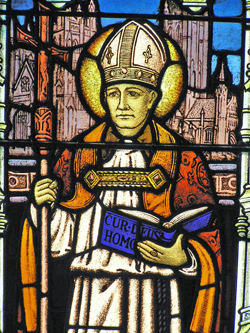Our Patron Saints
ST SILAS (sometimes referred to as St. Silvanus) was a prominent early Christian disciple, was regarded by St. Peter as a faithful brother, and accompanied St. Paul on his first and second missions.
During the second mission, St. Silas and St. Paul were imprisoned in Philippi, then freed by an earthquake that broke their chains and opened the prison door (see Acts 16: 25). St. Silas is sometimes depicted carrying broken chains.
With St. Paul and St. Timothy, St. Silas coauthored the two letters to the Thessalonians, and preached with St. Timothy at the church in Corinth. St. Silas died in Macedonia. His feast day is 13 July.
ST ANSELM was an Italian monk who became Archbishop of Canterbury. St. Anselm lived at a very interesting time in history. He was born in 1033 and died in 1109 - a long life in those times. He was raised by wealthy parents in Aosta, in the north of Italy. At age 15 St. Anselm became a monk, but this was disallowed by his father.
In his early 20s, St. Anselm set off in search of his life’s purpose. He eventually came to Bec, the site of a Benedictine abbey in Normandy, France. Here Anselm learned theology and became a skilled teacher and philosopher. He wrote papers to explain the deep mysteries of the Christian faith, and became the Prior of the abbey.
His tutor, Lanfranc, was soon in England, having been a lifelong friend of William the Conqueror. The Abbey was asked to care for some rundown English monasteries and properties. Lanfranc became Archbishop of Canterbury and soon enlisted Anselm’s support across the Channel. He visited England to inspect other monasteries and made quite the impression.
When Lanfranc died, Anselm was asked to step into the role of Archbishop of Canterbury. Although reluctant at first, Anselm succeeded his old mentor as Archbishop of Canterbury in 1092. His term as head of the Church in England was turbulent, often finding himself at odds with William Rufus and his successors.
St. Anselm passionately applied himself to his studies, reading and writing. At heart he was an academic. Christendom is forever indebted to St. Anselm for his great work, “Cur Deus Homo” (Why God was a Man), and his lifelong theme, “Faith Seeking Understanding." St. Anselm was a leading theologian of his time and is remembered for his writings and the encouragement he gave to those who used their intelligence in the service of religion. His feast day is 21 April.
Our Church is adorned by many beautiful artefacts from the former church of St Anselm’s, Middle Park. The sanctuary window depicts Anselm himself.
During the second mission, St. Silas and St. Paul were imprisoned in Philippi, then freed by an earthquake that broke their chains and opened the prison door (see Acts 16: 25). St. Silas is sometimes depicted carrying broken chains.
With St. Paul and St. Timothy, St. Silas coauthored the two letters to the Thessalonians, and preached with St. Timothy at the church in Corinth. St. Silas died in Macedonia. His feast day is 13 July.
ST ANSELM was an Italian monk who became Archbishop of Canterbury. St. Anselm lived at a very interesting time in history. He was born in 1033 and died in 1109 - a long life in those times. He was raised by wealthy parents in Aosta, in the north of Italy. At age 15 St. Anselm became a monk, but this was disallowed by his father.
In his early 20s, St. Anselm set off in search of his life’s purpose. He eventually came to Bec, the site of a Benedictine abbey in Normandy, France. Here Anselm learned theology and became a skilled teacher and philosopher. He wrote papers to explain the deep mysteries of the Christian faith, and became the Prior of the abbey.
His tutor, Lanfranc, was soon in England, having been a lifelong friend of William the Conqueror. The Abbey was asked to care for some rundown English monasteries and properties. Lanfranc became Archbishop of Canterbury and soon enlisted Anselm’s support across the Channel. He visited England to inspect other monasteries and made quite the impression.
When Lanfranc died, Anselm was asked to step into the role of Archbishop of Canterbury. Although reluctant at first, Anselm succeeded his old mentor as Archbishop of Canterbury in 1092. His term as head of the Church in England was turbulent, often finding himself at odds with William Rufus and his successors.
St. Anselm passionately applied himself to his studies, reading and writing. At heart he was an academic. Christendom is forever indebted to St. Anselm for his great work, “Cur Deus Homo” (Why God was a Man), and his lifelong theme, “Faith Seeking Understanding." St. Anselm was a leading theologian of his time and is remembered for his writings and the encouragement he gave to those who used their intelligence in the service of religion. His feast day is 21 April.
Our Church is adorned by many beautiful artefacts from the former church of St Anselm’s, Middle Park. The sanctuary window depicts Anselm himself.





